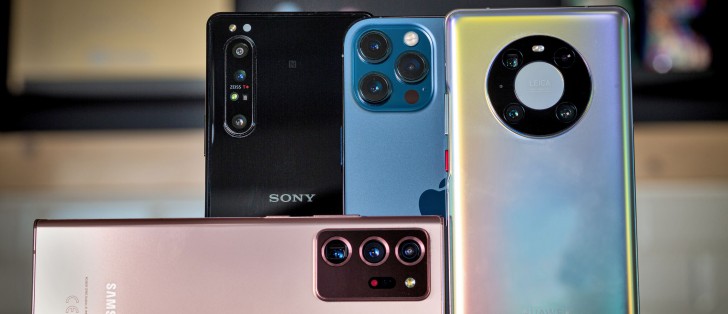Camera test: iPhone 12 Pro Max vs. Mate 40 Pro vs. Xperia 1 II vs. Galaxy Note20 Ultra

Portrait photos
Portrait modes between these are all over the place. The Xperia only lets you shoot portraits with the main cam at 1x zoom, the Galaxy offers you 1x and 2x magnifications, but both are captured on the main cam. Meanwhile, the Mate gives you 1x, 2x, and 3x magnifications in both a Portrait mode and an Aperture mode, each offering its own faux bokeh and the two modes differing in quality.
It's the iPhone that is the most straightforward - you can take portraits at 1x and 2.5x, and each uses the respective cam. It adds a Night Portrait mode, that one not available on the telephoto, as it doesn't have a Night mode at all.
With all these peculiarities, comparisons are hard to carry out in a remotely standardized way, but we tried anyway. Shooting at the widest magnification, here's what the images look like.




Portraits, 1x: Galaxy Note20 Ultra • iPhone 12 Pro Max • Mate 40 Pro • Xperia 1 II
The iPhone has the most faithful rendition of a human face with all the texture that's indeed there and zero skin smoothing. While we turned off all the beautification enhancements to the best of our ability, all three other phones draw the face with less detail, with the Xperia being outright soft.
None of the phones made any serious blunders with the subject isolation, and if you don't stare too closely at the top of the hair, this could almost pass for the real deal.

It gets even better at the 2.5x-ish setting - if you've got the 12 Pro Max, that is. The iPhone's picture is sharp, the subject separation is excellent, the tiny bokeh balls look nice, the blur is very realistic. It's as good as the shot above taken on a Sony a6500 with a Sigma 56mm f/1.4 lens wide open. Okay, almost as good.



Portraits, 2.5x-ish: Galaxy Note20 Ultra • iPhone 12 Pro Max • Mate 40 Pro
The Mate's rendition of out of focus highlights is quite good, too, while the Note's lights in the background are just blurred into the rest of it. However, the Galaxy's image is very soft, and we mean soft where it had to be sharp - the subject's face. The Mate's shot is bad in its own right - upscaled and sharpened beyond any reason.
Now, that's not the end for the Mate, though. Go into Aperture mode, and its zoomed-in portraits end up significantly better. Why is that? Beats us. The thing is, even at 1x zoom, the samples taken in Aperture mode have finer detail, compared to the Portrait mode ones.




Mate 40 Pro, Portrait vs. Aperture: Portrait, 1x • Aperture, 1x • Portrait, 2x • Aperture, 2x
Stepping outside for some torture testing, we placed our subject amidst some tree branches and fired away. Starting off with the widest setting again and shooting at a fairly distant subject, the results aren't spectacular, with blotches of sharpness and blurriness in the top left of the frame. The subject is well outlined, however, and the busy leaf-covered ground is made somewhat less distracting.




Portraits, 1x: Galaxy Note20 Ultra • iPhone 12 Pro Max • Mate 40 Pro • Xperia 1 II
We made this one a little more interesting by introducing a leaf immediately next to the camera for a nice blurry foreground. This does take your eyes off the mess in the top left corner, but a second look in there reveals the arbitrary blurring and the artificial nature of the effect.




Portraits, 1x: Galaxy Note20 Ultra • iPhone 12 Pro Max • Mate 40 Pro • Xperia 1 II
The zoomed-in level pictures have us more convinced. The tighter framing leaves less clutter for the algorithms to work out whether to blur or not and helps create a lot more believable results.



Portraits, 2.5x-ish: Galaxy Note20 Ultra • iPhone 12 Pro Max • Mate 40 Pro
Here's how that shot looks when taken on a proper camera.

Our attempt at low-light portraiture involved turning off most of the lighting in the little black studio you may have seen in our video reviews. A single LED panel was used to light the subject, at its minimum setting, though we didn't measure the actual light levels.

In any case, that proved too little light for the Xperia, which turned in a very soft image throughout - both background and subject.
The others didn't flinch and served up decently sharp portraits, certainly very good for the circumstances. Subject isolation is excellent on all three. The fake plant's twigs in the background couldn't pass for an extension of the subject's hair. The only objectionable bit is the Galaxy's white balance - our subject certainly isn't this purple in real life.




Portraits, 1x: Galaxy Note20 Ultra • iPhone 12 Pro Max • Mate 40 Pro • Xperia 1 II
Reader comments
- Hossien
- 28 Apr 2023
- cSx
No phone in the world can take pictures as well as a camera, a phone is something that is always available. The camera is not always available, but the phone is everywhere. If a random scene happens, the camera is not available to you, you have to ...
- Anonymous
- 03 May 2022
- fD9
imma tell you what, i know a thing or two about taking photos and i would take a proper camera over this
- Anonymous
- 06 Mar 2022
- Y7I
That's why I have a Sony RX100 VI for trips and outings when I want better pictures than with my phone. I can zoom in optically a lot and it has a nice picture quality. No need for a DSLR unless you are a paid photographer or need it for work or...